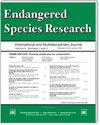描述墨西哥湾极度濒危米氏鲸栖息地的密度面模型
IF 2.9
2区 环境科学与生态学
Q2 BIODIVERSITY CONSERVATION
引用次数: 0
摘要
摘要:新发现的莱斯鲸(Balaenoptera ricei)是世界上最濒危的大型鲸鱼物种之一,主要栖息在墨西哥湾(GoMex)东北部大陆架断裂附近的区域。我们分析了 2003-2019 年期间在整个墨西哥湾北部收集到的目测线描调查数据,并利用密度面建模方法绘制了空间明确的密度图,以研究米氏鲸密度与水深和海洋学特征之间的关系。我们发现水深、表层 chl a 浓度、底层温度和底层盐度是界定大米鲸栖息地的关键参数。这与沿大陆架断裂上涌的高盐度冷水和来自沿海的高产表层水的季节性输入是一致的。墨西哥湾的主要环流模式,包括环流漩涡的存在,导致了生产力的提高,并可能在维持赖斯鲸所需的高密度觅食物种方面发挥作用。对模型的推断表明,墨西哥湾墨西哥水域还有更多区域可能适合大米鲸的生存。这项研究为指定美国《濒危物种法》规定的重要栖息地提供了信息,并将有助于海洋空间规划活动,以避免风能开发和水产养殖对大米鲸造成额外的人为影响。本文章由计算机程序翻译,如有差异,请以英文原文为准。
A density surface model describing the habitat of the Critically Endangered Rice’s whale Balaenoptera ricei in the Gulf of Mexico
ABSTRACT: The newly recognized Rice’s whale Balaenoptera ricei is among the most endangered large whale species in the world and primarily occupies a region near the continental shelf break in the northeastern Gulf of Mexico (GoMex). We analyzed visual line-transect survey data collected throughout the northern GoMex from 2003-2019 and developed spatially explicit density maps using a density surface modeling approach to examine relationships between Rice’s whale density and bathymetric and oceanographic features. We identified water depth, surface chl a concentration, bottom temperature, and bottom salinity as key parameters that define the Rice’s whale habitat. This is consistent with upwelling of cold, high-salinity water along the continental shelf break and seasonal input of high-productivity surface water originating from coastal sources. The dominant circulation patterns in the GoMex, including the presence of Loop Current eddies, lead to increased productivity and likely play a role in maintaining high densities of forage species needed to support Rice’s whales. Extrapolation of the model suggests additional regions in Mexican waters of GoMex that may be suitable for Rice’s whales. This study informs the designation of critical habitat as defined by the US Endangered Species Act and will assist in marine spatial planning activities to avoid additional anthropogenic impacts to Rice’s whales associated with the development of wind energy and aquaculture.
求助全文
通过发布文献求助,成功后即可免费获取论文全文。
去求助
来源期刊

Endangered Species Research
BIODIVERSITY CONSERVATION-
CiteScore
5.50
自引率
6.50%
发文量
38
审稿时长
31 weeks
期刊介绍:
ESR is international and interdisciplinary. It covers all endangered forms of life on Earth, the threats faced by species and their habitats and the necessary steps that must be undertaken to ensure their conservation. ESR publishes high quality contributions reporting research on all species (and habitats) of conservation concern, whether they be classified as Near Threatened or Threatened (Endangered or Vulnerable) by the International Union for the Conservation of Nature and Natural Resources (IUCN) or highlighted as part of national or regional conservation strategies. Submissions on all aspects of conservation science are welcome.
 求助内容:
求助内容: 应助结果提醒方式:
应助结果提醒方式:


